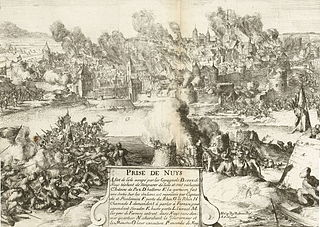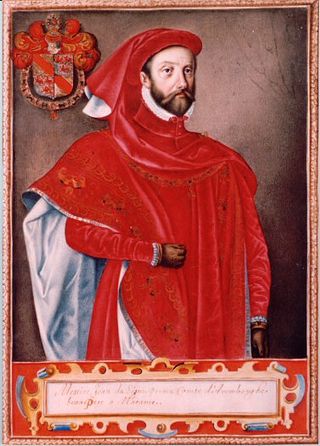
Jean de Ligne, Duke of Arenberg was Baron of Barbançon, founder of the House of Arenberg and stadtholder of the Dutch provinces of Friesland, Groningen, Drenthe and Overijssel from 1549 until his death.

The County of Isenburg was a region of Germany located in southern present-day Hesse, located in territories north and south of Frankfurt. The states of Isenburg emerged from the Niederlahngau, which partitioned in 1137 into Isenburg-Isenburg and Isenburg-Limburg-Covern. These countships were partitioned between themselves many times over the next 700 years.
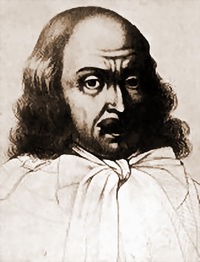
Franz Freiherr von Mercy, Lord of Mandre and Collenburg, was a German field marshal in the Thirty Years' War who fought for the Imperial side and was commander-in-chief of the Bavarian army from 1643 to 1645. In that role, he destroyed a French army at Tuttlingen (1643), stalemated another at Freiburg (1644), destroyed a third French army at Herbsthausen (1645) and was killed at the Second Battle of Nördlingen (1645).
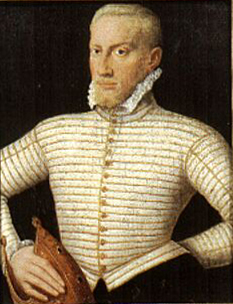
Gebhard Truchsess von Waldburg was the archbishop-elector of Cologne from 1577 to 1588. After pursuing an ecclesiastical career, he won a close election in the cathedral chapter of Cologne over Ernst of Bavaria. After his election, he fell in love with and later married Agnes von Mansfeld-Eisleben, a Protestant canoness at the Abbey of Gerresheim. His conversion to Calvinism and announcement of religious parity in the electorate triggered the Cologne War.
John of Isenburg-Grenzau was the Count of Isenburg-Grenzau from 1554 until 1556, and the Archbishop-Elector of Trier from 1547 until 1556.

Salentin IX of Isenburg-Grenzau (c. 1532–1610) was the Archbishop-Elector of Cologne as "Salentin of Isenburg" from 1567 until 1577, the Bishop of Paderborn from 1574 until 1577, and the Count of Isenburg-Grenzau from 1577 to 1610.
Isenburg-Grenzau was the name of several states of the Holy Roman Empire, seated in the Lordship of Grenzau, in modern Rhineland-Palatinate, Germany. The first state called Isenburg-Grenzau existed 1158–1290; the second 1341–1439; and the third 1502–1664.
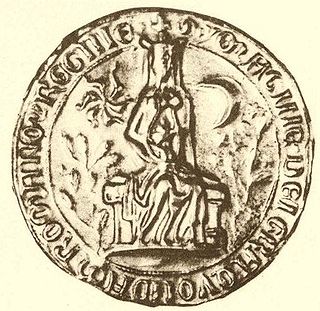
Imagina of Isenburg-Limburg was the Queen consort of Adolf of Nassau, King of Germany.
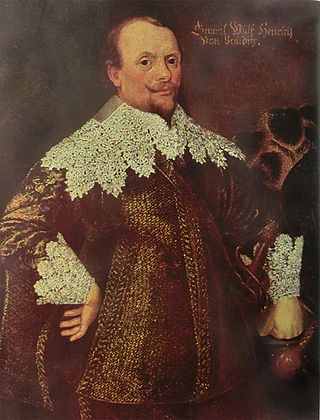
Wolf Heinrich von Baudissin or Bauditz (1579–1646) was a distinguished Protestant German cavalry commander who rose to the rank of field marshal during the Thirty Years' War.

Princely Count Charles of Arenberg, duke of Aarschot, baron of Zevenbergen, knight of the Order of the Golden Fleece, was the second Princely Count of Arenberg and a leading aristocrat of the Habsburg Netherlands, who served as a courtier, soldier, minister and diplomat.
The Countship of Isenburg-Limburg was a state of the Holy Roman Empire in the 13th and 14th centuries, based around the city of Limburg an der Lahn in modern Hesse, Germany.
Gerlach IV of Isenburg-Limburg, also known as Gerlach I of Limburg, was from 1258 Count of (Isenburg-)Limburg, ruling over the town of Limburg an der Lahn and some villages in its hinterlands. He was the founder of the short-lived House of Limburg.

The Cologne War was a conflict between Protestant and Catholic factions that devastated the Electorate of Cologne, a historical ecclesiastical principality of the Holy Roman Empire, within present-day North Rhine-Westphalia, in Germany. The war occurred within the context of the Protestant Reformation in Germany and the subsequent Counter-Reformation, and concurrently with the Dutch Revolt and the French Wars of Religion.
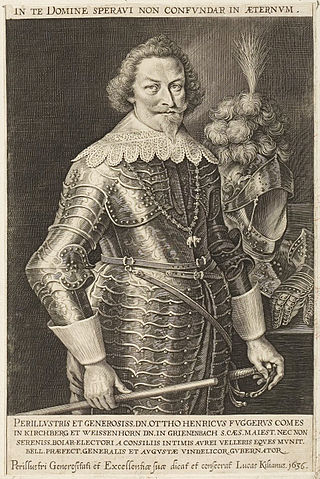
Otto Heinrich Fugger, Count of Kirchberg and Weissenhorn was a German professional soldier in Imperial and Bavarian service during the Thirty Year's War. Born into the ennobled mercantile family Fugger, he chose a military career in which he became a Knight of the Golden Fleece and served as governor and military commander of Augsburg.
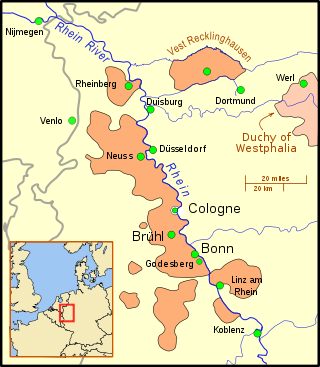
The destruction of the Oberstift, which included Linz, Ahrweiler, and other small towns and villages, occurred in the opening months of the Cologne War, from Christmas Day, 1582 until the end of March, 1583. Over these few weeks, armies of the competing archbishops of Cologne burned the southernmost villages, cloisters, and small towns.
Wirich VI, Count of Daun-Falkenstein was a German nobleman, diplomat, statesman, and politician. By descent, he was a Count of Falkenstein, and by inheritance, he was Lord of Broich and Lord of Bürgel. He belonged to the lower nobility in the Duchy of Berg and was a member of the Estates of Berg. He supported the Reformation in the Lower Rhine area.

The Grenzau Feud was a warlike conflict between the troops of Koblenz in the Electorate of Trier on the one hand and Lord Philip of Isenburg and Lord Reynard of Westerburg on the other at Grenzau on 20 April 1347. The Koblenz soldiers were ambushed and 172 were killed.
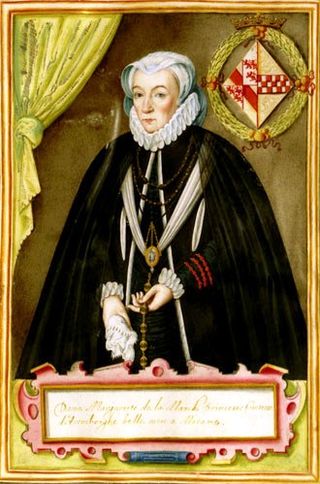
Margaret de La Marck-Arenberg (1527–1599) was a ruling countess of Arenberg from 1544 to 1599.

Jan van der Croon, also called Jan della Croon, Johann de la Corona, or von der Cron, was a Dutch professional soldier and military commander in Spanish and Imperial service who reached the rank of lieutenant field marshal. Rising from a common soldier to an important officer, regiment holder, and city commander during the Thirty Years' War, he continued his career after the Peace of Westphalia in the military administration of Bohemia. For many years until his death, he served as city commander of Prague and vice military commander of Bohemia, strengthening fortifications and recruiting soldiers for the Second Northern War and the Austro-Turkish War.










